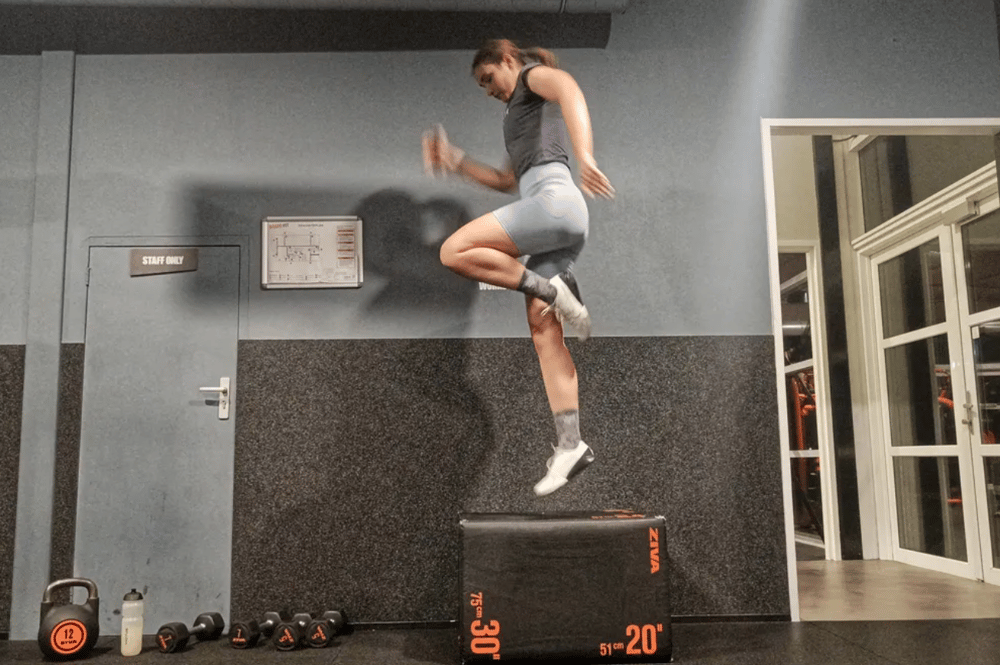PLYOMETRIC TRAINING FOR AGILITY
fitness Nutrition Mindset Jul 31, 2025 11:22:17 PM Kyle Receno 8 min read

Plyometric training, characterized by explosive, high-intensity movements, is a powerful method to enhance agility, speed, and coordination. By targeting fast-twitch muscle fibers, plyometrics improve quickness and responsiveness, making them ideal for athletes in sports like soccer, basketball, or tennis, as well as anyone seeking better movement efficiency. This blog explores the science of plyometrics, their benefits for agility, and a practical routine to boost performance.
Why Plyometrics Boost Agility
Agility is the ability to change direction quickly and efficiently while maintaining control. Plyometric exercises train the stretch-shortening cycle, where muscles rapidly lengthen and contract, enhancing power and reaction time. This improves neuromuscular coordination, enabling faster, more precise movements.
Key Benefits:
- Enhanced Agility: Improves ability to pivot, dodge, or sprint.
- Increased Power: Boosts explosive strength for quick movements.
- Better Coordination: Enhances body control during dynamic activities.
- Injury Prevention: Strengthens muscles and joints to handle rapid changes.
- Improved Athletic Performance: Supports sports requiring quick directional shifts.
Principles of Plyometric Training
Effective plyometric training emphasizes quality over quantity, focusing on explosive, controlled movements. Key principles include:
- Maximal Effort: Perform each rep with full intensity to mimic agility demands.
- Proper Form: Prioritize technique to prevent injury.
- Progressive Overload: Gradually increase intensity or volume as strength improves.
- Adequate Recovery: Allow 48–72 hours between sessions to avoid overtraining.
Top Plyometric Exercises for Agility
Below are effective plyometric exercises to enhance agility. Perform these 2–3 times per week, ideally after a dynamic warm-up. Ensure proper form and a soft landing surface (e.g., grass or padded mat) to reduce impact.
1. Lateral Bounds
Purpose: Improves side-to-side agility and lower-body power.
- How to Perform: Stand on one leg, jump laterally as far as possible, landing softly on the opposite leg. Stabilize, then jump back. Keep knees slightly bent.
- Reps/Sets: 2–3 sets of 10–12 reps per side.
- Tip: Focus on distance and control, not height.
2. Box Jumps
Purpose: Builds explosive power and coordination for quick movements.
- How to Perform: Stand in front of a sturdy box (12–24 inches high). Jump onto the box with both feet, landing softly, then step down.
- Reps/Sets: 3 sets of 8–12 reps.
- Tip: Start with a lower box and progress as confidence grows.
3. Skater Jumps
Purpose: Enhances lateral quickness and balance.
- How to Perform: Leap sideways from one leg to the other, landing softly with a slight knee bend. Swing arms for momentum and mimic a skating motion.
- Reps/Sets: 2–3 sets of 12–15 reps per side.
- Tip: Keep landings quiet to ensure control.
4. Tuck Jumps
Purpose: Boosts vertical power and rapid muscle activation.
- How to Perform: From a standing position, jump explosively, bringing knees toward chest. Land softly and immediately repeat.
- Reps/Sets: 3 sets of 8–10 reps.
- Tip: Avoid excessive forward lean; focus on quick, controlled jumps.
5. Agility Ladder Drills
Purpose: Improves foot speed and coordination for multidirectional agility.
- How to Perform: Use an agility ladder or mark lines on the ground. Perform patterns like high-knee runs, lateral shuffles, or in-and-out steps, moving quickly through the ladder.
- Reps/Sets: 3–4 sets of 6–8 passes through the ladder.
- Tip: Keep steps light and precise; increase speed as technique improves.
Sample Plyometric Workout (15–20 Minutes)
Incorporate this routine into your training to boost agility:
- Warm-Up (5 Minutes): Dynamic stretches (e.g., leg swings, high knees) and light jogging to prepare muscles.
- Lateral Bounds: 3 sets of 10 reps per side.
- Box Jumps: 3 sets of 10 reps.
- Skater Jumps: 3 sets of 12 reps per side.
- Tuck Jumps: 3 sets of 8 reps.
- Agility Ladder Drills: 3 sets of 6 passes (alternate patterns).
- Cool-Down (5 Minutes): Static stretches for quads, hamstrings, and calves.
Tips for Success
- Prioritize Form: Focus on controlled landings to protect joints.
- Start Slow: Beginners should use lower intensity (e.g., shorter jumps) to build strength.
- Rest Adequately: Take 60–90 seconds between sets and 48–72 hours between sessions.
- Combine with Strength Training: Pair with squats or deadlifts to support muscle power.
- Use Proper Footwear: Wear supportive shoes with good traction to prevent slips.
Common Mistakes to Avoid
- Poor Landing Mechanics: Landing heavily or with locked knees increases injury risk.
- Overtraining: Too many sessions or reps can lead to fatigue or strain.
- Skipping Warm-Ups: Cold muscles are more prone to injury.
- Ignoring Surface: Hard surfaces like concrete can stress joints; use softer ground or mats.
Who Can Benefit?
Plyometric training for agility is ideal for:
- Athletes: Soccer, basketball, or tennis players needing quick directional changes.
- Fitness Enthusiasts: Those aiming to improve speed and coordination.
- Recreational Sports: Enhances performance in casual games or activities.
- Rehabilitation: Supports recovery from injury (under professional guidance).
Additional Considerations
- Nutrition: Consume 1.6–2.2g protein/kg body weight and 4–6g carbs/kg daily to fuel performance and recovery.
- Hydration: Drink 0.7–1 oz water/kg body weight daily to support muscle function.
- Mobility Work: Pair with stretching or foam rolling to maintain joint health.
Conclusion
Plyometric training, with exercises like lateral bounds, box jumps, and agility ladder drills, is a dynamic way to boost agility and prevent injuries. By incorporating these movements into your routine with proper form and progression, you can enhance quickness, coordination, and performance. Start with the sample workout and consult a coach for tailored guidance.
Disclaimer: Consult a fitness professional before starting plyometric training, especially if you have joint issues or injuries.
